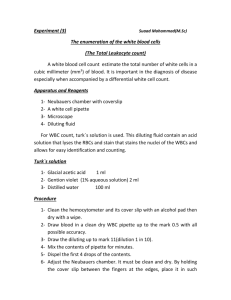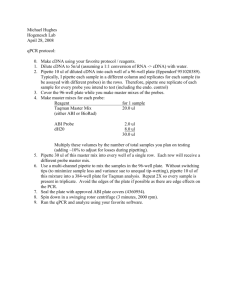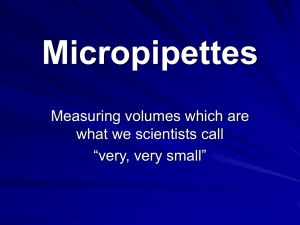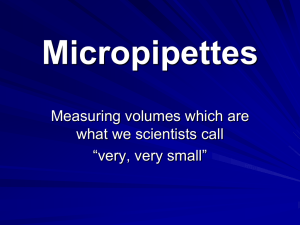Pipette training for students Introduction: Pipetting is one of the basic
advertisement
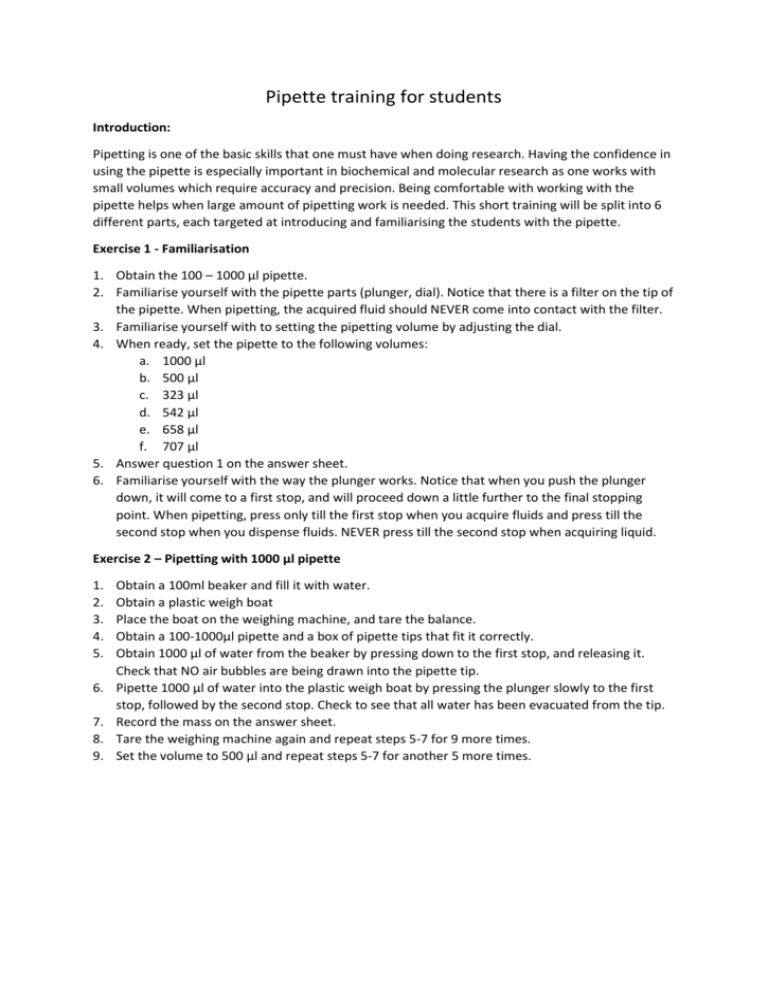
Pipette training for students Introduction: Pipetting is one of the basic skills that one must have when doing research. Having the confidence in using the pipette is especially important in biochemical and molecular research as one works with small volumes which require accuracy and precision. Being comfortable with working with the pipette helps when large amount of pipetting work is needed. This short training will be split into 6 different parts, each targeted at introducing and familiarising the students with the pipette. Exercise 1 - Familiarisation 1. Obtain the 100 – 1000 μl pipette. 2. Familiarise yourself with the pipette parts (plunger, dial). Notice that there is a filter on the tip of the pipette. When pipetting, the acquired fluid should NEVER come into contact with the filter. 3. Familiarise yourself with to setting the pipetting volume by adjusting the dial. 4. When ready, set the pipette to the following volumes: a. 1000 μl b. 500 μl c. 323 μl d. 542 μl e. 658 μl f. 707 μl 5. Answer question 1 on the answer sheet. 6. Familiarise yourself with the way the plunger works. Notice that when you push the plunger down, it will come to a first stop, and will proceed down a little further to the final stopping point. When pipetting, press only till the first stop when you acquire fluids and press till the second stop when you dispense fluids. NEVER press till the second stop when acquiring liquid. Exercise 2 – Pipetting with 1000 μl pipette 1. 2. 3. 4. 5. 6. 7. 8. 9. Obtain a 100ml beaker and fill it with water. Obtain a plastic weigh boat Place the boat on the weighing machine, and tare the balance. Obtain a 100-1000μl pipette and a box of pipette tips that fit it correctly. Obtain 1000 μl of water from the beaker by pressing down to the first stop, and releasing it. Check that NO air bubbles are being drawn into the pipette tip. Pipette 1000 μl of water into the plastic weigh boat by pressing the plunger slowly to the first stop, followed by the second stop. Check to see that all water has been evacuated from the tip. Record the mass on the answer sheet. Tare the weighing machine again and repeat steps 5-7 for 9 more times. Set the volume to 500 μl and repeat steps 5-7 for another 5 more times. Exercise 3 – Pipetting with 100 μl pipette 1. Familiarise yourself by setting the pipette to the following volumes: a. 100.0 μl b. 50.0 μl c. 87.3 μl d. 12.3 μl e. 35.5 μl f. 10.2 μl 2. Answer question 2 on the answer sheet. 3. Repeat steps 5 to 9 of Exercise 2, but with 100.0 μl and 50.0 μl volumes. Excerise 4 – Pipetting with 10 μl pipette 1. Familiarise yourself by setting the pipette to the following volumes: a. 10.00 μl b. 5.00 μl c. 8.18 μl d. 4.23 μ e. l3.13 μl f. 1.01 μl 2. Answer question 3 on the answer sheet. 3. Proceed to exercise 5. You are spared from pipetting with the 10 μl pipette. For now. Exercise 5 – Final test. With all that you have learnt, using the appropriate pipettes and tips, complete the following task. 1. Obtain a 1.5 μl pipette tube and record the mass on the weighing balance. 2. Pipette 500 μl of water into a 1500 μl pipette tube. Using a marker, mark out the water level on the surface of the tube. 3. Pipette 50 μl of water from the 1500 μl tube into a smaller pipette tube. Repeat this for another 9 times, dividing the water into 10 tubes. 4. Pipette 10 μl of water from one of the pipette tube into another pipette tube. Repeat this for another 9 times to divide the 50 μl into 10 tubes. 5. Repeat this for 2 other tubes containing 50 μl of water. 6. Pipette the water in all the tubes back into the original 1500 μl pipette tube. Compare the water level with the previously marked level. 7. Place the tube on the weighing balance and record the mass. Answer sheet Questions 1) What is the range of volumes the 1000 μl pipette can accurately dispense? __________________________________________________________________________________ 2) What is the range of volumes the 100 μl pipette can accurately dispense? __________________________________________________________________________________ 3) What is the range of volumes the 10 μl pipette can accurately dispense? __________________________________________________________________________________ Exercise 2 – Pipetting with 1000 μl pipette 1000 μl Mass/g 500 μl 1 1 2 2 3 3 4 4 5 5 6 Ave 7 8 9 10 Ave Mass/g Exercise 3 – Pipetting with 100 μl pipette 100.0 μl Mass/g 50.0 μl 1 1 2 2 3 3 4 4 5 5 6 Ave 7 8 9 10 Ave Exercise 5 – Final test. Mass/g Empty Final Mass/g

